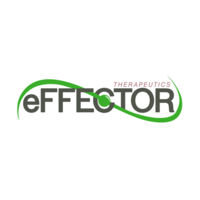预约演示
更新于:2025-12-04
eFFECTOR Therapeutics, Inc.
更新于:2025-12-04
概览
标签
肿瘤
血液及淋巴系统疾病
皮肤和肌肉骨骼疾病
小分子化药
疾病领域得分
一眼洞穿机构专注的疾病领域
暂无数据
技术平台
公司药物应用最多的技术
暂无数据
靶点
公司最常开发的靶点
暂无数据
| 排名前五的药物类型 | 数量 |
|---|---|
| 小分子化药 | 5 |
| 化学药 | 1 |
关联
6
项与 eFFECTOR Therapeutics, Inc. 相关的药物作用机制 CDK4抑制剂 [+1] |
在研机构 |
原研机构 |
最高研发阶段批准上市 |
首次获批国家/地区 美国 |
首次获批日期2017-09-28 |
靶点 |
作用机制 eIF4A抑制剂 |
非在研适应症- |
最高研发阶段临床2期 |
首次获批国家/地区- |
首次获批日期- |
作用机制 MNK1抑制剂 [+1] |
最高研发阶段临床2期 |
首次获批国家/地区- |
首次获批日期- |
13
项与 eFFECTOR Therapeutics, Inc. 相关的临床试验NCT05744739
Phase 1 Dose Escalation Study of Tomivosertib in Relapsed or Refractory Acute Myeloid Leukemia (AML)
Phase 1 of the study will open first with a (Bayesian optimal interval BOIN) dose finding design. The starting dose of tomivosertib is 100mgdaily (doses 24 ± 2 hours apart), PO, self-administered with meals. The dose finding follows a BOIN design, with the 100mg BID dose level with a meal being the highest dose. There is one dose level below (dose level -1 = 100mg QD without a meal) that will be given if the de-escalation condition is met during dose finding. Upon completion of the phase 1 dose finding portion of the study, the recommended starting dose of tomivosertib for the subsequent combination with the other agents will be determined, as described in Section 4.3 and Section 8.0.
Tomivosertib will be dosed continuously on days 1-28 of each 28-day cycle at the dose level assigned for that cohort.
Tomivosertib will be dosed continuously on days 1-28 of each 28-day cycle at the dose level assigned for that cohort.
开始日期2023-09-29 |
申办/合作机构 |
NCT05101564
An Umbrella, Randomized, Controlled, Pre Operative Trial Testing Integrative Subtype Targeted Therapeutics in Estrogen Receptor Positive, HER2-Negative Breast Cancer
The purpose of this study is to learn if adding a new drug that is targeted at a specific genetic change found in some breast tumors pre-operatively will slow the growth of the tumor more than standard anti-hormone therapy used to treat this type of breast cancer. Different therapies are being tested based on the specific gene changes in the tumor. Not every tumor will have a gene change that is being studied.
开始日期2023-03-20 |
申办/合作机构  Stanford University Stanford University [+3] |
NCT04632381
A Phase 1b, Randomized, Double-Blind, Placebo-Controlled, Dose Escalation Trial of Intravenous Zotatifin in Adults With Mild or Moderate Coronavirus Disease 2019 (COVID-19)
To evaluate the safety and tolerability, the antiviral activity, and plasma pharmacokinetics (PK) of zotatifin administered intravenously (IV) to adults with mild or moderate COVID-19.
开始日期2021-07-01 |
申办/合作机构 |
100 项与 eFFECTOR Therapeutics, Inc. 相关的临床结果
登录后查看更多信息
0 项与 eFFECTOR Therapeutics, Inc. 相关的专利(医药)
登录后查看更多信息
6
项与 eFFECTOR Therapeutics, Inc. 相关的文献(医药)2025-07-29·PROCEEDINGS OF THE NATIONAL ACADEMY OF SCIENCES OF THE UNITED STATES OF AMERICA
eIF4A controls translation of estrogen receptor alpha and is a therapeutic target in advanced breast cancer
Article
作者: Xu, Jianing ; Mai, Nicholas ; Pareja, Fresia ; Li, Zhuoning ; Sperry, Sam ; Chiang, Gary G. ; Worland, Stephan ; Yang, Guangli ; Reiter, Jason M. ; Chang, Qing ; Dorso, Madeline A. ; Thompson, Peggy A. ; Boyer, Jacob A. ; Ouerfelli, Ouathek ; Gadal, Sunyana ; Amor, Corina ; Chandarlapaty, Sarat ; Wendel, Hans-Guido ; Rosen, Neal ; Kannan, Ram ; Drilon, Alexander ; Warner, Douglas ; Chen, Xiaoping ; Rosen, Ezra Y. ; Sharma, Malvika ; Miele, Matthew ; de Stanchina, Elisa
Most breast cancers depend on hormone-stimulated estrogen receptor alpha (ER) activity and are sensitive to ER inhibition. Resistance can arise from activating mutations in the gene encoding ER (
ESR1
) or from reactivation of downstream targets. Newer ER antagonists occasionally show efficacy but are largely ineffective as single agents in the long term. Here, we show that ER translation is eIF4E/cap-independent yet sensitive to inhibitors of the translation initiation factor eIF4A. EIF4A inhibition reduces the expression of ER and cell cycle regulators such as cyclin D1. This leads to growth suppression in ligand-independent breast cancer models, including those driven by ER mutants and fusion proteins. Efficacy is enhanced by adding the ER degrader, fulvestrant. The combination further lowers ER expression and blocks tumor growth in vitro and in vivo. In an early clinical trial (NCT04092673), the eIF4A inhibitor zotatifin was combined with either fulvestrant or fulvestrant plus CDK4 inhibitor, abemaciclib, in patients with acquired resistance to these agents. Multiple clinical responses including a handful of durable regressions were observed, with little toxicity. Thus, eIF4A inhibition could be useful for treating ER+ breast cancer resistant to other modalities.
2021-12-01·Cancer chemotherapy and pharmacology4区 · 医学
Single- and multiple-dose pharmacokinetics, potential for CYP3A inhibition, and food effect in patients with cancer and healthy subjects receiving ipatasertib
4区 · 医学
Article
作者: Meng, Raymond ; Musib, Luna ; Tabernero, Josep ; Sane, Rucha ; Malhi, Vikram ; Huang, Jian ; Liederer, Bianca ; Deng, Yuzhong ; Budha, Nageshwar ; Patel, Premal ; Cervantes, Andres
PURPOSE:
To examine the single- and multiple-dose pharmacokinetics (PK), CYP3A inhibition potential of ipatasertib, and effect of food on PK of ipatasertib in patients with refractory solid tumors and a dedicated food effect assessment in healthy subjects.
METHODS:
The Phase I dose-escalation study enrolled patients with solid tumors in a standard 3 + 3 design with a 1 week washout after the first dose, followed by once-daily dosing on a 3-week-on/1-week-off schedule. In the expansion cohort, the effect of ipatasertib on CYP3A substrate (midazolam) was assessed by examining the change in midazolam exposure when dosed in the absence and presence of steady-state ipatasertib at 600 mg. The effect of food on ipatasertib PK was studied with ipatasertib administered in fed or fasted state (6 patients from Phase I patient study and 18 healthy subjects from the dedicated food effect study).
RESULTS:
Ipatasertib was generally well tolerated at doses up to 600 mg given daily for 21 days. Ipatasertib showed rapid absorption (tmax, 0.5-3 h), was dose-proportional over a range of 200-800 mg, had a median half-life (range) of 45.0 h (27.8-66.9 h), and had approximately two-fold accumulation following once-daily dosing. Midazolam exposure (AUC0-∞) increased by 2.2-fold in the presence of ipatasertib. PK was comparable in subjects administered ipatasertib in a fed or fasted state.
CONCLUSION:
Ipatasertib exhibited rapid absorption and was dose-proportional over a broad dose range. Ipatasertib appeared to be a moderate CYP3A inhibitor when administered at 600 mg and could be administered with or without food in clinical studies.
TRAIL REGISTRATION:
NCT01090960 (registered March 23, 2010); NCT02536391 (registered August 31, 2015).
2021-01-01·Molecular cancer therapeutics2区 · 医学
Targeting Oncogene mRNA Translation in B-Cell Malignancies with eFT226, a Potent and Selective Inhibitor of eIF4A
2区 · 医学
Article
作者: Fish, Sarah ; Clarine, Jeff ; Sung, Eric ; Thompson, Peggy A. ; Nevarez, Andres ; Xiang, Alan ; Staunton, Jocelyn ; Nilewski, Christian ; Parra, Ana ; Gerson-Gurwitz, Adina ; Chen, Joan ; Sperry, Samuel ; Eam, Boreth ; Young, Nathan P. ; Reich, Siegfried H. ; Chiang, Gary G. ; Barrera, Maria ; Michels, Theodore ; Tran, Chinh ; Sprengeler, Paul A. ; Wegerski, Christopher J. ; Howard, Haleigh ; Webster, Kevin R. ; Ernst, Justin T. ; Packard, Garrick K.
Abstract:
The PI3K/AKT/mTOR pathway is often activated in lymphoma through alterations in PI3K, PTEN, and B-cell receptor signaling, leading to dysregulation of eIF4A (through its regulators, eIF4B, eIF4G, and PDCD4) and the eIF4F complex. Activation of eIF4F has a direct role in tumorigenesis due to increased synthesis of oncogenes that are dependent on enhanced eIF4A RNA helicase activity for translation. eFT226, which inhibits translation of specific mRNAs by promoting eIF4A1 binding to 5′-untranslated regions (UTR) containing polypurine and/or G-quadruplex recognition motifs, shows potent antiproliferative activity and significant in vivo efficacy against a panel of diffuse large B-cell lymphoma (DLBCL), and Burkitt lymphoma models with ≤1 mg/kg/week intravenous administration. Evaluation of predictive markers of sensitivity or resistance has shown that activation of eIF4A, mediated by mTOR signaling, correlated with eFT226 sensitivity in in vivo xenograft models. Mutation of PTEN is associated with reduced apoptosis in vitro and diminished efficacy in vivo in response to eFT226. In models evaluated with PTEN loss, AKT was stimulated without a corresponding increase in mTOR activation. AKT activation leads to the degradation of PDCD4, which can alter eIF4F complex formation. The association of eFT226 activity with PTEN/PI3K/mTOR pathway regulation of mRNA translation provides a means to identify patient subsets during clinical development.
100
项与 eFFECTOR Therapeutics, Inc. 相关的新闻(医药)2025-11-27
·百度百家
Effector Therapeutics,这家坐落于加州圣地亚哥的制药企业,正是抗癌新势力中的佼佼者。圣地亚哥,被誉为“全美排行第一的生物技术与制药行业聚落”,孕育了众多创新企业,而Effector Therapeutics便是在这片沃土上崭露头角的一家。该公司专注于选择性转化调节剂小分子抗癌药物的研发,致力于为患者带来更多治疗选择。
▍ 公司背景与愿景
Effector Therapeutics成立于2012年,汇聚了行业资深的管理团队和科学创始人。公司基于大卫·鲁格罗博士和凯万·肖卡特博士实验室的开创性研究,探索癌症新疗法,并获得了加州大学旧金山分校的翻译分析技术专有应用许可。加州大学旧金山创新、技术和联盟办公室拥有丰富的活性发明和知识产权许可证,其技术已成功商业化,为全球患者带来了众多疗法和产品。这为Effector Therapeutics提供了强大的技术支持和商业前景。
▍ 成功合作与资金支持
在2021年1月,Effector Therapeutics与全球制药领军企业辉瑞达成独家许可合作,共获5.07亿美元资金支持,双方将共同研发真核生物起始因子4E(EIF4E)的小分子抑制剂。自2017年辉瑞领投的3860万美元C系列融资以来,这家成立不足十年的公司便持续受到全球制药行业的瞩目。这种综合性与全球领先制药公司的合作为公司的抗癌药物研发提供了强大的资源和支持。
Effector Therapeutics的团队成员在各自领域内都具有深厚的经验和卓越的能力,这成为公司成功的关键因素之一。
▍ 管理团队
公司总裁兼首席执行官Steve Worland博士,拥有密歇根大学生物化学学士学位和加州大学伯克利分校化学博士学位,并在美国国立卫生研究院哈佛大学担任过分子生物学博士后研究员。他在制药行业积累了25年的丰富经验,曾担任辉瑞公司副总裁兼抗病毒研究主管,以及多家知名制药公司的要职。至2015年,Steve Worland博士还担任生物制药公司Tracon Pharmaceuticals,Inc.的董事会成员。
▍ 科学团队
此外,Effector Therapeutics的联合创始人Kevan Shokat博士,是加州大学旧金山分校细胞和分子药理学系教授、加州大学伯克利分校化学系教授,同时也是霍华德休斯医学研究员。还有Davide Ruggero博士,作为海伦·迪勒家族基金会基础研究主席、翻译控制和癌症领域的先驱,为公司的科研方向提供了宝贵的支持。其他管理团队的成员如Siegfried Reich博士、凯文·伊斯特伍德以及詹姆斯·阿普尔曼博士等,都在各自的领域内发挥重要作用。
在癌症治疗领域,Effector Therapeutics凭借其选择性转化调节技术平台和前沿的科学探索,不断推进新药的研发和应用。
▍ 新疗法与技术平台
Effector Therapeutics在其抗癌药物的研发过程中,基于开创性研究推出了多个抗癌药物候选。比如EFT508、EFT226和EIF4E,它们分别针对蛋白质转化机制的不同元素,显示出对不同类型癌症的潜在疗效。这种创新的科学技术平台是公司能够在抗癌领域立于不败之地的关键。
▍ 选择性转化调节剂抑制剂(STRIs)
Effector Therapeutics正致力于开发一种新型肿瘤药物——选择性转化调节剂抑制剂(STRIs)。这种药物利用其专有的选择性转化调节技术平台,针对转录和翻译过程的关键环节进行调控,为癌症治疗提供新策略。 STRIs 药物的这种特性,为难治性癌症患者带来新的希望。
▍ EFT508的发展与临床试验
EFT508是Effector Therapeutics的核心产品之一。它经历了多次临床试验和药物组合测试,展示出显著的疗效。在2015年12月的美国血液学会会议上,EFT508首次亮相,并迅速在临床试验中取得突破。2017年获得美国FDA授予的孤儿药资格,以及随后与辉瑞和默克公司的合作,都推动了EFT508的临床测试进程。在2018和2019年,EFT508又在不同癌症类型的治疗中取得了新的进展。
▍ EFT226的突破与潜力
EFT226是针对EIF4A的新药物,在抗肿瘤和抗病毒方面展现潜力。公司在芝加哥举办的美国癌症研究协会年会上揭晓了EFT226的最新研究进展。这种抑制剂能够同时抑制多种关键肿瘤基因的表达,且在动物模型和临床前实验中显示出强大的体内功效。在2020年,随着COVID-19疫情的全球爆发,EFT226的潜在抗病毒特性也得到了广泛关注。
▍ 全球合作与愿景
Effector Therapeutics与辉瑞公司的合作,旨在推动EIF4E抑制剂的开发。这一合作不仅彰显了翻译调控领域的重要地位,也为公司带来了更广泛的研发资源和全球认可。期待着与辉瑞的共同努力,Effector Therapeutics能够在未来为癌症患者提供更多的治疗选择和技术突破。
在这抗癌道路充满挑战的时代,我们寄望于Effector Therapeutics能在不久的将来,为我们揭示全新的治疗途径,为癌症患者带来更多的希望。
2025-06-24
关注并星标CPHI制药在线日前,深圳开悦生命科技有限公司的1类新药KY2液体硬胶囊在国内获得临床试验默示许可,用于治疗DHX33阳性的晚期实体瘤。 KY2是一款靶向RNA解旋酶DHX33的口服小分子药物,具有精准治疗、体内半衰期较长的技术特点。2025年2月,KY2获FDA临床试验默示许可,准许在美国开展针对晚期实体瘤的1期临床试验。 KY2是继KY1(KY386注射用浓溶液)之后,开悦生命第二款获批临床的产品。KY1也是一款靶向RNA解旋酶DHX33的小分子抑制剂,但是一款注射剂。2024年6月,KY1在国内获批临床,用于治疗DHX33阳性的复发/难治性晚期恶性肿瘤。值得一提的是,KY1曾先后被FDA授予两项孤儿药资格,分别用于治疗肝细胞癌和胃癌。 开悦生命是一家深耕RNA解旋酶小分子药物研发的创新型公司,2023年6月完成数千万人民币Pre-A轮融资。除了KY1和KY2,开悦生命还有一款针对晚期实体瘤的项目,即KY3,目前处于临床前阶段。RNA解旋酶抑制剂进展 RNA解旋酶是参与RNA代谢的最大的蛋白质家族,其功能涉及胚胎发育、细胞增殖、血细胞生成、代谢、癌症、免疫调控、炎症反应及自身免疫性疾病等。研究发现,很多解旋酶在癌症病理条件下会失调,表达量增高,或者在病理的条件下通过形成特殊的蛋白复合物发挥一些肿瘤特异性的促进作用。 目前,全球尚无RNA解旋酶靶向药获批上市,但RNA解旋酶家族内越来越多的药物靶点被发现,如eIF4A、DDX3X、DDX5、DHX9。其中,eIF4A,即RNA结合蛋白和翻译因子真核起始因子4A,是一种重要的RNA解旋酶,其能够解开mRNA 5'UTR的复杂结构,从而促进翻译起始。在多种癌症中,eIF4A的活性被发现与肿瘤的侵袭性密切相关。 2025年3月Cancer Cell上在线发表题为Small-molecule RNA therapeutics to target prostate cancer的研究表明:eIF4A靶向小分子抑制剂zotatinfin通过重塑雄激素受体(AR)和HIF1α的5'UTR RNA结构,减少了这些关键癌基因的选择性翻译,且可增强前列腺癌细胞对雄激素阻断治疗和放疗的敏感性,有望为克服前列腺癌耐药性提供新的策略。 麦吉尔大学的Jerry Pelletier团队研发了第二代eIF4A RNA解旋酶抑制剂MG-002,其能降低癌基因c-MYC的蛋白表达量。研究发现,靶向c-MYC能抑制三阴乳腺癌的转移。这意味着MG-002有望通过降低c-MYC的mRNA翻译从而治疗三阴性乳腺癌。 值得一提的是,早在2020年1月,辉瑞就与Effector Therapeutics达成独家全球许可和合作协议,共同开发EIF4E小分子抑制剂以治疗多种癌症。 DHX33属于RNA解旋酶DEAH-box家族,其通过解旋RNA双链结构,调控核糖体生物合成与致癌基因转录两大核心进程。研究发现,DHX33在非小细胞肺癌、乳腺癌及胃癌等多种癌症中高表达。DHX33通过结合rDNA启动子,驱动核糖体RNA(rRNA)转录,为癌细胞提供指数级增长的蛋白质合成能力。DHX33抑制剂可直接切断癌细胞增殖所需的“弹药供应链”,实现“饿死”肿瘤。同时,DHX33抑制剂可解除对p53蛋白的磷酸化抑制,使p53恢复对DNA损伤的监控功能。 DHX9也属于RNA解旋酶DEAH-box家族,是一种ATP依赖性RNA解旋酶,可解旋RNA或DNA双链体,以及DNA:RNA杂交体,在转录、翻译和维持基因组稳定性中起着至关重要的作用。研究发现,DHX9基因敲除会导致病理性DNA/RNA 杂交体(R环)的积累,从而引起复制叉处的转录碰撞,造成单链和双链DNA断裂,并增加基因组的不稳定性。 DHX9被广泛报道可促进癌细胞的增殖、侵袭和转移,并与不良预后显著相关。研究发现其缺失或化学抑制会触发敏感肿瘤细胞中R环以及复制应激和DNA损伤标志物的积累。微卫星不稳定性(MSI)相关癌症(如MSI-H型结直肠癌)以及同源重组修复缺陷(HRD)型肿瘤对DHX9表现出强烈的依赖性。此外,DHX9在自身免疫性疾病的发生发展中也可能发挥一定作用,但具体机制尚不完全清楚。 Accent Therapeutics开发了两款DHX9抑制剂,即ATX-559和ATX968。其中ATX-559于2024年10月获FDA批准临床,治疗BRCA1或BRCA2缺陷型乳腺癌患者以及MSI-H和/或 dMMR 实体瘤,目前正在开展1/2期临床。ATX968是一种强效且选择性DHX9抑制剂,小鼠体内PK结果显示其口服300mg/kg,暴露量在12小时内高于EC90值。在MSI-H和dMMR结直肠癌异种移植小鼠模型中,ATX968以300 mg/kg一天两次进行给药,可以显著消退肿瘤,在给药28天后停止给药,肿瘤体积也几乎没有增大。 我国勤浩医药基于片段的药物设计策略也成功开发出一类全新分子结构的变构DHX9抑制剂GH3595,目前处于临床前阶段。体外实验表明,该系列化合物在ATP酶活性实验中显示出低纳摩尔级的抑制效力,并能特异性抑制MSI-H型结直肠癌和HRD型乳腺癌细胞的增殖。在体内实验中,GH3595系列化合物在小鼠体内具有良好的药代动力学特性及安全性特征。而且,GH3595-001通过每日口服给药方案,可显著诱导MSI-H型和HRD型移植瘤消退,且实验过程中未观察到动物体重下降等不良反应。总结 RNA解旋酶家族蛋白的成药性是国内外药企翘首期盼的领域,然而目前全球尚无针对RNA解旋酶的药物获批上市。不过,国内外已有部分药企开始布局该领域,我国药企开悦生命作为该领域的先驱,目前已有2款产品获批临床。期待RNA解旋酶抑制剂领域早日迎来重大突破。END来源:CPHI制药在线声明:本文仅代表作者观点,并不代表制药在线立场。本网站内容仅出于传递更多信息之目的。如需转载,请务必注明文章来源和作者。投稿邮箱:Kelly.Xiao@imsinoexpo.com▼更多制药资讯,请关注CPHI制药在线▼点击阅读原文,进入智药研习社~
临床1期孤儿药临床申请快速通道
2025-01-04
·药事纵横
声明:因水平有限,错误不可避免,或有些信息非最及时,欢迎留言指出。本文仅作医疗健康相关药物介绍,非治疗方案推荐(若涉及);本文不构成任何投资建议。
2024年,全球医药研发领域经历了一系列令人瞩目的临床试验失败事件,这些失败不仅揭示了新药研发过程的复杂性和挑战,也促使制药企业重新审视其研发策略和临床试验设计。从慢性阻塞性肺病药物到帕金森病治疗药物,从肿瘤免疫疗法到基因疗法,多个领域的临床研究在历经长时间和大量资源投入后,未能达到其主要终点或关键次要终点。
本文汇总了2024年发生的110个重要临床试验失败案例,并对一些失败研究进行详细介绍,探讨失败的原因、影响及对未来新药研发的启示,以期提供参考和借鉴。
一月
1月5日,Theravance Biopharma宣布Yupelri(revfenacin)吸入溶液用于慢性阻塞性肺病(COPD)维持治疗的IV期PIFR-2研究未达主要终点。Yupelri 是美国批准用于慢阻肺维持治疗的唯一每日一次的雾化长效毒蕈碱拮抗剂(LAMA)。
1月16日,Allakos宣布lirentelimab在治疗特应性皮炎患者的2期临床试验(ATLAS)和治疗慢性自发性荨麻疹患者的2b期临床试验(MAVERICK)中均未达主要终点。
1月22日,吉利德公布Trop2 ADC新药Trodelvy治疗非小细胞肺癌的三期临床EVOKE-01研究没有达到OS主要终点。EVOKE-01正在评估Trop2 ADC药物Trodelvy®(sacituzumab-govitecan-hziy;SG)与多西他赛在铂类化疗和检查点抑制剂治疗期间或之后进展的转移性或晚期NSCLC患者中的疗效。
1月29日,百时美施贵宝(BMS)宣布其PD-1抑制剂Opdivo在III期CheckMate-914研究的B部分中失败,对于术后存在高复发风险的局部肾细胞癌患者未带来显著的无病生存益处。
1月29号,来凯医药公布afuresertib联合紫杉醇治疗耐药卵巢癌(PROC)(PROFECTA-II)的顶线数据。试验结果表明,afuresertib联合紫杉醇治疗可以降低疾病展或死亡的风险(无进展生存期,PFS ),HR为0.744(95%CI:0.502-1.102),但试验结果不具有统计学意义。
二月
2月5日,亚虹医药发布公告宣布其产品APL1202与化疗灌注联合使用治疗化疗灌注复发的中高危非肌层浸润性膀胱癌(NMIBC)的随机、双盲、对照、多中心的关键性临床试验未达到主要研究终点,公司决定终止APL-1202与化疗灌注联合使用在该适应症的进一步开发。
2月7日,Gilead宣布终止CD47单抗magrolimab治疗急性髓性白血病(AML)的3期ENHANCE-3研究,FDA将所有magrolimab治疗骨髓增生异常综合征(MDS)和急性髓性白血病的研究,包括相关的扩大准入项目置于全面临床搁置状态。这些决定是根据独立数据监测委员会的建议做出的,该委员会审查了ENHANCE-3总生存期(OS)中期分析计划的一线数据。在该分析中,magrolimab与阿扎胞苷和venetoclax联用显示出无治疗效果,并观察到死亡风险增加,主要是由感染和呼吸衰竭引起的。
2月8日,Synlogic公司宣布终止Synpheny-3研究,该研究是对labafenogene marselecobac (SYNB1934)作为苯丙酮尿症(PKU)的一种潜在治疗方法正在进行的Ⅲ期临床研究。SYNB1934是利用合成生物学改造的细菌菌株,具有降解苯丙氨酸的能力。终止Synpheny-3试验的决定是基于即将进行的独立数据监测委员会(DMC)评估前的内部审查结果,该结果表明该试验不太可能达到主要终点。
2月8日,阿斯利康在2023年全年业绩报告上公布因疗效不佳,决定终止抗IL-33单抗Tozorakimab联合达格列净治疗糖尿病肾病的IIb期临床研究(NCT04170543)。
2月12日,AN2 Therapeutics宣布自愿暂停无缝II/III期临床试验(EBO-301)中III期研究部分的患者入组,该试验旨在评估口服小分子细菌leucyl-tRNA合成酶抑制剂epetraborole治疗由鸟分枝杆菌复合体(MAC)引起的难治性肺病的疗效与安全性。在对正在进行的第二阶段研究进行盲法汇总分析后,发现疗效可能低于预期,因此决定自愿暂停试验。
2月12日,大冢制药公布了AVP-786(氘代右美沙芬+奎尼丁)治疗阿尔茨海默病痴呆相关激越的III期临床试验(NCT03393520)未达主要疗效终点。
2月13日,Roivant Sciences在财报中披露终止开发SF3B1调节剂RVT-2001用于治疗骨髓增生异常综合征的临床I/II期试验,原因是期中分析结果后有效性不及预期。
2月16日,Denali Therapeutics在SEC文件中透露,DNL788(SAR443820)治疗肌萎缩侧索硬化症(ALS)的II期HIMALAYA研究未能达到显著改善修订版ALS功能评定量表(ALSFRS-R)评分的主要终点。受此消息影响,Denali的股价下跌了近8%。
三月
3月4日,Vivoryon Therapeutics公布了口服谷氨酰胺酰环化酶(QPCT)抑制剂varoglutamstat(PQ912)治疗早期阿尔茨海默病(AD)IIb期VIVIAD研究的初步结果。结果显示,VIVIAD研究未达到其主要终点,也未显示出认知能力随时间推移而发生变化的显著统计学差异。此外,该研究未达到测量认知能力、日常生活活动工具问卷和脑电图 全局θ功率的关键次要终点。
3月7日,MacroGenics在2023年财报中透露因IMGC936在针对晚期恶性实体瘤的I/II期临床试验中未达到预期内的安全性和有效性目标,将终止该药物的开发。IMGC-936是由MacroGenics原研,后与ImmunoGen(现已被艾伯维收购)合作开发的一款ADAM9 ADC药物。
3月8日,Amylyx Pharmaceuticals公布AMX0035治疗肌萎缩性侧索硬化症(ALS)三期临床PHOENIX的顶线数据,研究没有达到主要终点和次要终点。Amylyx将与监管进行沟通,包括自愿撤市的计划。
3月11日,Acadia Pharmaceuticals公布Pimavanserin治疗精神分裂阴性症状三期临床ADVANCE-2的最新研究结果未达主要终点。研究的主要终点为NSA-16总分从基线到第26周的变化,治疗组和安慰机组26周NSA-16评分分别为-11.8 vs -11.1%,结果不具有统计学意义。安全性和耐受性与之前的临床试验一致,不良事件发生率较低。
3月21日,罗氏合作伙伴Chugai制药(中外制药)公布了Enspryng(萨特利珠单抗)治疗全身型重症肌无力(gMG)的III期LUMINESCE研究结果。虽在其主要终点观察到具有统计学意义的数据,但结果没有达到对临床获益程度的预期。
3月21日,默沙东宣布其PD-1疗法Keytruda联合维持性PARP抑制剂Lynparza(奥拉帕利)一线治疗某些转移性非鳞状非小细胞肺癌(NSCLC)患者的III期KEYLYNK-006试验未达到总生存期(OS)和无进展生存期(PFS)的双重主要终点。
3月28日,BMS宣布1-磷酸鞘氨醇 (S1P) 受体口服小分子调节剂 Zeposia(ozanimod),治疗中重度活动性克罗恩病患者的安慰剂对照临床III期试验YELLOWSTONE研究失败,在第12周未达到临床缓解的主要终点。
四月
4月1日,Gritstone bio宣布其个性化癌症疫苗GRANITE在一线转移性微卫星稳定结直肠癌(MSS-CRC)中正在进行的II/III期研究的II期部分的数据。总体来说,该癌症疫苗未能触发循环肿瘤DNA(ctDNA)的变化,导致II期试验未达主要终点。
4月4日,eFFECTOR Therapeutics公布了tomivosertib的一项随机、安慰剂对照II期KICKSTART研究的主要分析结果。基于分层对数秩检验,PFS双侧P值为0.21,未达到p≤0.2的预设阈值。Tomivosertib组的中位生存期为13.0周,安慰剂组的中位生存期为11.7周。总生存期结果仍不成熟,但没有观察到有利于tomivosertib的趋势。
4月15日,Marius Pharmaceuticals公布静脉注射ganaxolone(加奈索隆)治疗难治性癫痫持续状态(RSE)的三期临床RAISE最新数据,此次中期分析未达到预设的终止标准。IDMC建议临床试验继续,Marinus决定完成RAISE试验约100例患者的入组工作,预计在今年夏季得出顶线结果,结果出来后决定是否继续开发。
4月17日,Sage Therapeutics宣布一项针对帕金森病 (PD) 轻度认知障碍 (MCI) 患者的研究性口服药物dalzanemdor (SAGE-718) 的双盲、安慰剂对照2期研究PRECEDENT研究的初步结果未达到主要终点,即在第42天时接受每日一次dalzanemdor治疗的患者与接受安慰剂治疗的患者在WAIS-IV编码测试得分方面与基线相比不存在显著统计学差异。Dalzanemdor (SAGE-718)的耐受性总体良好,没有发现新的安全信号。
4月18日,Biosplice Therapeutics宣布CLK/DYRK激酶抑制剂lorecivivint治疗膝骨关节炎的III期试验OA-21短期疼痛研究未达到第12周疼痛减轻的主要终点。Biosplice目前正在分析这些初步的OA-21试验结果。
五月
5月6日,Lyra Therapeutics的核心管线LYR-210在治疗慢性鼻窦炎(CRS)的3期研究中未能达到临床主要终点。后续,Lyra公司宣布,将裁撤管线、停止制造和商业化活动、裁员75%等措施来削减成本以节省资金,保证资金继续推动LYR-210的3期研究和公司运营。
5月6日,GlycoMimetics宣布其主要候选产品uproleselan,在与化疗联合治疗成人复发或难治性急性髓系白血病(R/R AML)的III期研究中未达到总生存期(OS)主要终点。结果显示,与单独化疗相比,uproleselan联合化疗组的OS并没有统计学意义的显著改善。
5月10日,百时美施贵宝(BMS)宣布纳武利尤单抗(Opdivo,O药)治疗不可切除的局部晚期III期NSCLC患者的III期CheckMate-73L研究未达到主要终点。
5月13日,默沙东宣布终止3期KeyVibe-010试验中的抗TIGIT药物vibostolimab 和抗PD-1pembrolizumab(帕博利珠单抗) 联合制剂组治疗皮肤癌的后期试验,由于免疫副作用导致大量患者退出。该试验正在评估vibostolimab和帕博利珠单抗的研究组合,与单独使用帕博利珠单抗相比,作为切除的高风险黑色素瘤(ⅡB -Ⅳ期)患者的辅助治疗。
5月13日,盐野义公布新冠口服药Ensitrelvir三期临床最新数据,研究没有达到主要终点治疗到持续症状缓解的时间,尽管数据有所降低,但没有达到统计学显著性差异。盐野义将继续与监管层沟通。
5月28日,康宁杰瑞宣布在未接受系统性治疗的不可切除局部晚期或转移性胰腺导管腺癌(PDAC)患者中,评估其自主研发的PD-L1/CTLA-4双特异性抗体KN046联合白蛋白紫杉醇及吉西他滨对比安慰剂联合白蛋白紫杉醇及吉西他滨的疗效及安全性的III期KN046-303研究已经达到预设的死亡事件数,总生存期(OS)结果未达到预设的统计学终点。
5月30日,吉利德公布Trop2 ADC治疗晚期尿路上皮癌(mUC)三期临床TROPiCS-04的最新数据,研究没有达到OS主要终点,此外,试验还发现,Trodelvy与更多的早期死亡病例相关,主要由于中性粒细胞减少导致的副作用。吉利德正在进一步分析数据,并将与FDA讨论。
六月
6月12日,辉瑞宣布其杜氏肌营养不良症基因疗法PF-06939926治疗杜氏肌营养不良症(DMD)的III期临床CIFFREO失败,与安慰剂相比,PF-06939926在III期试验中未达到主要和关键次要终点。
6月17日,武田公布了其同类首创的强效选择性胆固醇24-羟化酶 (CH24H) 抑制剂Soticlestat (TAK-935)的SKYLINE和SKYWAY研究的顶线数据。SKYWAY (TAK-935-3002)3期研究评估了 Soticlestat 联合标准治疗与安慰剂联合标准治疗对难治性Lennox-Gastaut综合征 (LGS)患者的疗效。与安慰剂相比,Soticlestat未能达到降低严重运动减退性癫痫发作频率的主要终点。
6月17日,Marinus Pharmaceuticals宣布了3期双盲、随机、安慰剂对照RAISE试验(NCT04391569)的初步结果仅达到了两个关键终点中的一个。公司将继续分析RAISE的全部数据集,并计划与美国FDA接触,讨论静脉注射加奈索隆治疗RSE的潜在发展方向。
6月18日,阿斯利康宣布其首创AKT抑制剂Truqap(capivasertib)与紫杉醇联合治疗局部晚期(无法手术)或转移性三阴性乳腺癌(TNBC)患者的CAPItello-290 III期试验未达到双重主要终点,即在整个试验人群或肿瘤携带特定生物标志物改变(PIK3CA、AKT1或PTEN)的亚组患者中,总生存期(OS)与紫杉醇联合安慰剂相比均有所改善。在CAPItello-290中,Truqap与紫杉醇联用的安全性与每种药物的已知安全性基本一致,没有发现新的安全性问题。
6月20日,Jazz制药公布了T型钙通道调节剂suvecaltamide(JZP385)在成人原发性震颤(ET)患者中的IIb期临床试验(NCT05122650)主要结果,与安慰剂相比,30mg suvecaltamide在主要终点(原发性震颤分级评估量表(TETRAS)改良综合结局评分从基线到第12周的变化)和次要终点(临床总体印象-严重程度量表(CGI-S)评分)上,没有达到统计学意义。
6月24日,德国默克宣布终止TrilynX III期随机研究,该研究评估了口服的凋亡抑制蛋白(IAPs)拮抗剂xevinapant联合化放疗(CRT)治疗未切除的局部晚期头颈部鳞状细胞癌(LA SCCHN)患者的效果。该决定是在该研究的独立数据监控委员会进行了预先计划的中期分析后做出的,该委员会认为该试验不太可能达到延长无事件生存期的主要目标。消息发布后,德国默克股价下跌8%。
6月24日,G1 Therapeutics公布了其3期PRESERVE 2试验的最终OS分析结果,该试验评估了CDK4/6抑制剂曲拉西利(trilaciclib)在转移性三阴性乳腺癌(TNBC)患者化疗(吉西他滨和卡铂;GCb)前给药的疗效和安全性,该研究未显示出具有统计学意义的治疗效果。
七月
7月4日,罗氏宣布II/III期SKYSCRAPER-06研究未达到主要终点,该研究旨在评估tiragolumab+Tecentriq (atezolizumab)+化疗 vs. pembrolizumab+化疗一线治疗局部晚期不可切除或转移性非鳞状非小细胞肺癌患者。该研究的主要终点无进展生存期(PFS)的风险比(HR)为1. 27(95%CI:1.02,1.57),总生存期(OS)的HR为1.33(95%CI:1.02,1.73)。
7月8日,HilleVax公司公布了NEST-IN1的初步数据结果未达主要终点。受此消息影响,Hillevax当天股价大跌88%。
7月12日,据clinicaltrials.gov网站显示,礼来终止了BTLA单抗LY3361237治疗中度活动型系统性红斑狼疮(SLE)的一项II期研究(NCT05123586),原因为缺乏疗效。
7月18日,AVEO Oncology宣布其口服的下一代血管内皮生长因子受体 (VEGFR) 酪氨酸激酶抑制剂 (TKI) Tivozanib(商品名:Fotivda)联合纳武利尤单抗(O药)二线/三线治疗晚期转移性肾细胞癌(RCC)患者的III期TiNivo-2研究未达到主要终点。试验的主要结果是无进展生存期,次要终点包括总生存期、总缓解率、缓解持续时间和安全性。
7月24日,Sage Therapeutics和Biogen宣布了口服研究药物SAGE-324 (BIIB124)治疗特发性震颤(ET)的KINETIC 2 2期剂量范围研究未达主要终点。SAGE-324是一款在研口服神经活性类固醇(NAS)GABAA 受体正性异位调节剂(PAM)。
7月29日,Ventyx Biosciences宣布,其变构TYK2抑制剂VTX958在中度至重度活动性克罗恩病患者进行的II期研究未达主要终点。Ventyx计划对现有数据进行进一步分析,并且不打算推进额外的临床试验。
八月
8月1日,Agios Pharmaceuticals公布了全球3期ACTIVATE-KidsT研究的初步结果未达主要终点,该研究针对1至18岁患有PK缺乏症且定期输血的儿童进行了Pyrukynd (mitapivat)治疗。
8月8日,礼来公司第二季度业绩电话会议上,首席科学官Daniel Skovronsky 透露口服抗 tau 药物LY3372689(一种 O-GlcNAcase (OGA) 抑制剂)在治疗早期症状性阿尔茨海默病的2 期研究中失败。试验组所有剂量与安慰剂相比均未达到首要终点,即预设的综合阿尔茨海默病评定量表 (iADRS) 较基线的变化。
8月21日,LEO Pharma 旗下公司Timber Pharmaceuticals公布了异维A酸外用软膏配方TMB-001治疗中重度先天性鱼鳞病患者的为期12周的3期ASCEND研究结果未达到所有主要和次要终点。与安慰剂相比,对TMB-001治疗有反应的中重度先天性鱼鳞病患者的比例没有统计学意义上的显著差异。
8月29日,Merck宣布终止抗PD-1单抗帕博利珠单抗(Keytruda)两项3期试验 KEYNOTE-867和 KEYNOTE-630。KEYNOTE-867(NCT03924869)研究中,Keytruda联合SBRT与安慰剂联合SBRT相比,在无事件生存期(EFS)或总生存期(OS)(分别为研究的主要终点和关键次要终点)方面均未显示出改善;KEYNOTE-630 (NCT03833167)研究中,Keytruda在主要终点RFS方面未达到统计学显著性。目前该研究的关键次要终点OS尚未正式得出,但已有分析结果显示Keytruda并不优于安慰剂。
九月
9月3日,Athira Pharma宣布了其fosgonimeton在轻度至中度阿尔茨海默病 (AD) 患者中的II/III期LIFT-AD临床试验的顶线结果。与安慰剂相比,该试验的主要终点全球统计检验(GST)评分及其关键次要终点ADAS-Cog11和ADCS-ADL23评分在26周时均未达到统计学意义。
9月8日,阿斯利康公布了其抗IL-33单克隆抗体tozorakimab在慢性阻塞性肺病(COPD)的2a期FRONTIER-4研究结果。该研究未能达到改善支气管扩张剂前的用力呼气量(FEV)(即患者用力呼气时所能呼出的空气量)这一主要终点。
9月11日,GSK宣布将停止其单纯疱疹病毒(HSV)疫苗GSK3943104的研发,该疫苗未通过TH HSV REC-003研究,未达有效性主要终点,后续不会进入3期研究。TH HSV REC-003试验是一项联合阶段I/II期概念验证研究,以评估GSK3943104的潜在临床有效性。
9月12日,Neurocrine Biosciences宣布其在研化合物luvadaxistat (NBI-1065844) 的ERUDITE II期临床研究未能达到其作为改善精神分裂症患者认知障碍的潜在治疗方法的主要终点。
9月12日,Fulcrum Therapeutics宣布losmapimod治疗面肩肱型肌营养不良症(FSHD)的III期REACH试验未能达到主要终点。此外,次要终点也没有统计学意义。losmapimod的安全性和耐受性与之前报告的研究结果一致。
9月13日,Atea Pharmaceuticals宣布了评估口服核苷酸聚合酶抑制剂bemnifosbuvir与安慰剂治疗COVID-19的全球III期SUNRISE-3试验未达到主要终点,即在2221名轻度至中度COVID-19高危患者组成的单药治疗队列中,到第29天全因住院或死亡人数的减少具有统计学意义。在SUNRISE-3研究中,bemnifosbuvir总体上安全且耐受性良好。
9月23日,阿斯利康和第一三共共同宣布TROP2 ADC德达博妥单抗(Dato-DXd)二/三线治疗HER2低表达或阴性乳腺癌患者的III期TROPION-Breast01研究未达到总生存期(OS)的主要终点。
9月25日,默沙东宣布,其PD-1抑制剂Keytruda与抗LAG-3抗体favezelimab的联合疗法,在一项针对微卫星稳定(MSS)转移性结直肠癌(mCRC)患者的临床III期试验(KEYFORM-007)中未能显著改善总生存期(OS)。
十月
10月8日,Sage Therapeutics宣布其在研NMDA受体正向变构调节剂 Dalzanemdor治疗阿尔茨海默病(AD)的II 期LIGHTWAVE研究未达到主要终点。
10月14日,Transgene公布了其治疗性癌症疫苗Tipapkinogen sovacivec(TG4001)最新的2期临床研究结果,与PD-L1抑制剂阿维鲁单抗(Avelumab)联用治疗HPV16阳性宫颈和肛门生殖器肿瘤未达到主要终点(改善无进展生存期)。
10月22日,Alto Neuroscience发布其在研疗法ALTO-100治疗重度抑郁症(Major depressive disorder)Ⅱb期研究未达到其主要终点。该临床试验结果的公布使得Alto股价在周二晚间的盘后交易中下跌了76%,市值也仅剩1.2亿美金。
10月29日,Spero Therapeutics宣布其在研非结核分枝杆菌肺病小分子治疗药物候选抗生素SPR720(Fobrepodacin)的Ⅱa期研究的中期分析未达到主要终点。公司暂停该项目,内部重组裁员约39%。
十一月
11月12日,Syros Pharmaceuticals公司宣布,tamibarotene治疗新诊断RARA基因过表达高危骨髓增生异常综合征患者的III期临床SELECT-MDS-1未能达到主要终点,与对照组相比,Tamibarotene+Azacitidine联合疗法未能显著提高某些MDS患者的完全缓解率。
11月12日,艾伯维宣布其用于治疗精神分裂症的M4激动剂Emraclidine在两项名为EMPOWER-1和EMPOWER-2的临床二期试验中,未达到其主要终点。受此消息的影响,艾伯维股价大跌超12%,市值蒸发约400亿美元。
11月15日,眼科公司Eyenovia宣布验证MicroPine(阿托品局部微量制剂)延缓儿童近视进展效果的III期CHAPERONE研究未达到主要终点(3年内视力进展低于0.5屈光度)。Eyenovia计划终止这项研究,更彻底地审查数据,并评估下一步工作。受此消息影响,Eyenovia股价下跌了70%。
11月24日,天士力医药集团股份有限公司宣布:因临床试验结果不达预期,其间接控股子公司赛远生物安美木单抗项目临床试验暂停,目前该试验处于II期临床阶段,并对开发支出余额1.62亿元全额计提资产减值准备。
11月25日,Cassava Sciences宣布Simufilam治疗轻度至中度阿尔茨海默病(AD)的III期ReThink-ALZ研究未达到预先指定的双重主要终点以及次要终点和探索性生物标志物终点。受此消息影响,Cassava Sciences的股价当日下跌了84%。
2024年11月26日,罗氏宣布其TIGIT抗体tiragolumab在3期 SKYSCRAPER-01研究中的最新进展,该研究评估了Tiragolumab联合 Tecentriq与单独使用Tecentriq对 PD-L1 高表达、局部晚期或转移性非小细胞肺癌 (NSCLC) 患者的疗效,该研究在最终分析时没有达到总生存率的主要终点。
十二月
12月3日,Roivant 旗下Kinevant Sciences 公司公告其核心资产namilumab用于结节病的中期临床试验失败,将终止开发。该研究主要终点和次要终点均没有达到。
12月4日,Relmada Therapeutics报告称REL-1017治疗重度抑郁症的3期 Reliance II 试验不太可能达到疗效目标。公司将重新评估数据,同时继续推进治疗代谢性疾病的 REL-P11项目。
12月7日,微芯生物公告其在研新药西奥罗尼胶囊单药治疗三线及以上小细胞肺癌Ⅲ期临床试验结果,在经过广泛抗肿瘤免疫治疗后的总体人群中,虽然西奥罗尼中位PFS(无进展生存期)显著延长,降低疾病进展风险70%以上,但在另一主要终点mOS(中位总生存期)上,与安慰剂组相比不具显著差异。
12月11日,Corcept Therapeutics发布了Dazucorilant治疗肌萎缩侧索硬化症(ALS)2期临床试验DAZALS的研究结果。DAZALS未达到其主要终点,即与接受安慰剂的患者相比,接受Dazucorilant治疗的患者在ALS功能评分量表-修订版(ALSFRS-R)中的变化。
2024年12月16日,UCB宣布,与诺华合作开发的 minzasolmin(一种研究性口服小分子 α-突触核蛋白错误折叠抑制剂)的 ORCHESTRA 帕金森病概念验证研究未达到其主要和次要临床终点。
12月19日,罗氏宣布了IIb期PADOVA研究的结果,该临床研究α-突触核蛋白(α-Syn)单抗 prasinezumab 在586名早期帕金森病患者中的疗效,这些患者接受了至少18个月的稳定症状治疗。Prasinezumab 在主要终点“确认运动进展时间”方面显示出潜在的临床疗效,HR=0.84 [0.69-1.01],p=0.0657,未达到统计学显著性。
2024年12月20日,Galectin Therapeutics 宣布其代谢功能障碍相关脂肪性肝炎(MASH)新药Belapectin的III期NAVIGATE研究顶线结果。结果显示,试验组未显示出具有统计学意义的临床获益,未达主要终点。
总结
2024年失败的临床研究中,53个为III期研究,27个为II期研究,8个为IIb期研究,5个为I/II期研究,5个为II/III期研究,4个为IIa期研究,2个为I期研究,1个为I/IIb期研究,1个为II/IIb期研究,1个为IV期研究。由此可见III期临床研究失败率最高,特别是在肿瘤领域,由于药物的特殊性以及对疗效和安全性的严格要求,III期临床研究的失败率可能会更高。例如,有数据显示在III期临床开发与监管申请递交之间,肿瘤临床研究的失败率为48%,明显高于非肿瘤临床研究的29%。
导致III期临床研究失败的原因多种多样,主要包括无法达到预期的疗效终点、严重的不良反应事件、疗效不佳等,基础研究不足、临床研究设计缺陷、剂量选择不当、数据收集和分析问题以及操作执行问题等,也可能导致III期临床研究失败。即使临床试验失利的消息频传,实际上能够挺进临床环节的分子已是百里挑一。我们仍要保持积极态度看待,毕竟新药研发之路处处存在反转,只要一息尚存,就有赢的可能。
参考资料:各公司公告
临床3期抗体药物偶联物临床结果免疫疗法临床2期
100 项与 eFFECTOR Therapeutics, Inc. 相关的药物交易
登录后查看更多信息
100 项与 eFFECTOR Therapeutics, Inc. 相关的转化医学
登录后查看更多信息
组织架构
使用我们的机构树数据加速您的研究。
登录
或

管线布局
2025年12月29日管线快照
管线布局中药物为当前组织机构及其子机构作为药物机构进行统计,早期临床1期并入临床1期,临床1/2期并入临床2期,临床2/3期并入临床3期
药物发现
1
1
临床前
早期临床1期
1
3
临床2期
其他
1
登录后查看更多信息
当前项目
| 药物(靶点) | 适应症 | 全球最高研发状态 |
|---|---|---|
Tomivosertib ( MNK1 x MNK2 ) | 非小细胞肺癌 更多 | 临床2期 |
阿贝西利 ( CDK4 x CDK6 ) | ER阳性子宫内膜癌 更多 | 临床2期 |
Zotatifin ( eIF4A ) | 晚期恶性实体瘤 更多 | 临床1/2期 |
elF4E (eFFECTOR Therapeutics) | 实体瘤 更多 | 早期临床1期 |
eIF4Ei ( EIF4E ) | 实体瘤 更多 | 临床前 |
登录后查看更多信息
药物交易
使用我们的药物交易数据加速您的研究。
登录
或

转化医学
使用我们的转化医学数据加速您的研究。
登录
或

营收
使用 Synapse 探索超过 36 万个组织的财务状况。
登录
或

科研基金(NIH)
访问超过 200 万项资助和基金信息,以提升您的研究之旅。
登录
或

投资
深入了解从初创企业到成熟企业的最新公司投资动态。
登录
或

融资
发掘融资趋势以验证和推进您的投资机会。
登录
或

生物医药百科问答
全新生物医药AI Agent 覆盖科研全链路,让突破性发现快人一步
立即开始免费试用!
智慧芽新药情报库是智慧芽专为生命科学人士构建的基于AI的创新药情报平台,助您全方位提升您的研发与决策效率。
立即开始数据试用!
智慧芽新药库数据也通过智慧芽数据服务平台,以API或者数据包形式对外开放,助您更加充分利用智慧芽新药情报信息。
生物序列数据库
生物药研发创新
免费使用
化学结构数据库
小分子化药研发创新
免费使用


